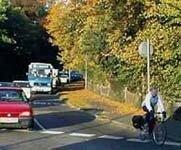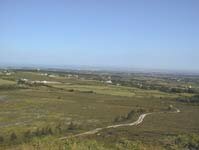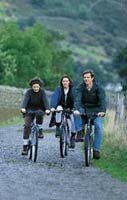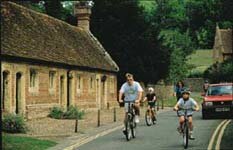|
(The text below is reprinted with the kind permission of Sustrans from the Official Guide to the National Cycle Network.)
 The National Cycle Network is a magnificent visionary scheme passing through all the major urban centres of the United Kingdom and linking these cities via 10,000 miles of traffic-free routes, quiet lanes and traffic-calmed city streets to form a comprehensive cycling network right across the country. It is a traffic partnership project par excellence - hundreds of bodies are involved, including local authorities, utility companies, landowners, heritage and wildlife bodies, rail operators and central government. The National Cycle Network is a magnificent visionary scheme passing through all the major urban centres of the United Kingdom and linking these cities via 10,000 miles of traffic-free routes, quiet lanes and traffic-calmed city streets to form a comprehensive cycling network right across the country. It is a traffic partnership project par excellence - hundreds of bodies are involved, including local authorities, utility companies, landowners, heritage and wildlife bodies, rail operators and central government.
The origins of Sustrans, an abbreviated form of Sustainable Transport, can be traced back to the significant date of July 7th 1977 (7/7/77) when a group of Bristol environmentalists, driven by a desire to do something about the dangers to the environment recently highlighted by the oil crisis, set up a cycling group known as Cyclebag. Within two years the group started a programme of building cycle routes which has continued unabated, although now on a vastly expanded scale, over the last 20 years.
The dismantled railway line running between Bristol and Bath was the first railway path they converted for use by cyclists and walkers. The five-mile stretch near Saltford was where Sustrans' great enterprise started, a vision initially made possible by back-breaking work undertaken by enthusiastic volunteers. Since that modest beginning, what started as a single five-mile linear route will become a 10,000-mile network covering the whole country, built at a cost of more than £400 million.
Sustrans is motivated by a desire to find solutions to the problems caused by the huge and relentless growth of traffic. Deaths, injuries, noise, pollution, the destruction of the environment and the creation of a lost generation of unfit children who will never have known the freedom offered by the bicycle, are all problems inherent in the traffic growth over the past 25 years. Every prediction indicates that things will get worse before they get better.
At the heart of the issue is the status and safety of cyclists and pedestrians in relation to the car. Proportionately, far more people cycle in Sweden, a country which is much colder, in Germany, which has a higher car ownership, and in Switzerland, which is considerably more hilly. Mile for mile, a cyclist in Britain is eight times more likely to be hurt in an accident than in Holland or Denmark.
In 1976 Denmark had the worst child accident rate in Europe - this led to an Act of Parliament which required local authorities to build safe cycle routes to school. Denmark is now one of the safest countries for cyclists in Europe. By contrast, Britain currently has the worst child accident rate in Europe and had to wait until 1998 before a Transport Bill was introduced that even mentioned Safe Routes to School. Britain has lost 30 years of cycle planning and Sustrans is pursuing strategies to bring cycling back into the public domain.
Following its success on the Bristol & Bath Railway Path, Sustrans made full use of the various employment schemes available in the early 1980s such as Youth Opportunities Programmes and the Community Programme with hundreds of young people helping to build more paths in other cities such as Plymouth and Glasgow. At one stage, Sustrans was in the unusual position of having just one paid employee (John Grimshaw) and 800 people working on these very useful employment programmes! Many of those who supervised the early gangs have since gone on to become Regional Managers, responsible for building the Network. No one can accuse them of lacking hands-on experience!
Negotiations with British Waterways began in 19080. Although there are 2,000 miles of canal towpaths in the country, only a portion are passable by bike and in those days the useable mileage was even smaller. The Kennet & Avon Canal near Bath was covered in a foot of impassable sludge during the winter months. This was to be Sustrans' first towpath project and such was the state of the canal banks when work began that all new volunteers were told that their first job was to drive the dumper truck straight into the canal then retrieve it. The reason? The dumper truck had so often slipped into the water from the muddy 'path' that knowing how to get it out again was a most important skill to acquire! Over five years (1984-88) the path was rebuilt in stone from Bath all the way to Devizes. It is now tremendously popular as both a walking and cycling route.
 Sustrans' reputation as path builders was growing year on year. More and more cities such as Derby, York, Liverpool and Sunderland had paths built through them. It became Sustrans' intention to have one quality route in each major city to show the government that the creation of attractive, safe cycle routes generated thousand of cycle journeys that might not otherwise have taken place, and enabled huge numbers of the public to learn to cycle again. Sustrans' reputation as path builders was growing year on year. More and more cities such as Derby, York, Liverpool and Sunderland had paths built through them. It became Sustrans' intention to have one quality route in each major city to show the government that the creation of attractive, safe cycle routes generated thousand of cycle journeys that might not otherwise have taken place, and enabled huge numbers of the public to learn to cycle again.
Great use was made of recycled materials in the construction of these cycle paths: bridges were made of concrete railway sleepers, sculptures were created from old JCBs and seats from wooden sleepers. Deliberate attempts were made to include attractive features such as causeways through cuttings, allowing ponds to be formed adjacent to the path, the creation of curves to break up the monotony of dead straight lines and bending the route to weave a way through mature trees. This concept of making each ride full of interesting features became known as the ''ravelling landscape''
After 15 years' experience of building paths, Sustrans began to capture the public imagination and launched a Supporter Programme. Supporter numbers rose from 200 in 1993 to 40,000 in 1999. By 1995 Sustrans was in a position to make a realistic bid to the Lottery for Millennium funds for the National Cycle Network, a vast and visionary scheme to create a 6,500-mile countrywide network of safe cycle routes by the year 2005 with 2,500 miles of the routes built by the year 2000. (The figure of 6,500 miles has since increased to 10,000 due to the enthusiasm for the project shown by local authorities all over the country).
The bid was successful and Sustrans was awarded £43.5 million. Although this is a huge amount, it only represents 20% of the total cost of the first phase of the project and the remainder of the funding comes from a variety of sources including local authorities, development agencies, the European Union, the Highways Agency, the cycle trade and industry, and from generous contributions from Sustrans supporters.
 Britain's roads are the busiest in Europe and predictions are that the situation will get worse, particularly in the countryside. Sustrans' aims in creating the Network are threefold: it should be attractive for novices, memorable for visitors and useful for everyday cyclists. The routes also promote a programme of sculpture and bring great economic benefit to many areas of the country. Britain's roads are the busiest in Europe and predictions are that the situation will get worse, particularly in the countryside. Sustrans' aims in creating the Network are threefold: it should be attractive for novices, memorable for visitors and useful for everyday cyclists. The routes also promote a programme of sculpture and bring great economic benefit to many areas of the country.
The National Cycle Network is designed to encourage the public to start cycling again. Sustrans believes that to persuade non-cyclists to take up cycling it is essential to provide them with safe, traffic-free routes so they can regain confidence. These special paths can then connect (ideally) traffic-calmed urban roads with a network of routes through the countryside using quiet roads carrying less than 1,000 vehicles a day (this may sound busy but works out at less than one car a minute).
In the cities the main thrust of Sustrans' work is to increase the profile and status of the cyclist by re-allocating road space to favour the cyclist over the car, for example in the provision of Advanced Stop Lines at traffic lights, reinforcing the idea that cyclists matter. Campaigning for lower speed limits in cities could lead to a drastic reduction in deaths and injuries to cyclists and pedestrians.
The Safe Routes to Schools Project aims to change one of Britain's most shameful statistics: only 2% of journeys to school are made by bike, despite a huge majority of children wanting to get out of their parents' cars and onto their bikes. In Denmark the figure is 60%. Britain is one of the very few countries in Europe where more people cycle to work than to school. The benefits of reversing this trend are made patently clear at a school in Ipswich where 60% of the children arrive by bike. The school has won many sports competitions with other schools simply because the pupils are so much fitter.
Sculpture has come to be synonymous with the building of new sections of the Network. Starting in Consett, funded by Northern Arts, Andy Goldsworthy created the Lampton Worm, a long serpent sculpture running alongside the path. All over the country sculptures began appearing, carved from wood, sculpted from stone, welded from steel or built of brick. The Royal Bank of Scotland generously donated 1,000 mileposts with different versions designed by England, Scottish, Welsh and Irish sculptors.
 Local economies have benefited enormously from the creation of Sustrans' long-distance routes. The first of these was the C2C (or Sea to Sea from the Cumbrian Coast to the North Sea) which led the way in featuring a mixture of traffic-free paths and on-road sections. Within a year of its opening 10,000 people had cycled the trail and spent over £1 million in the bed & breakfasts, Youth Hostels, pubs, cafes and shops along the way. In 1995 the C2C was the Global Winner of the 'British Airways Tourism for Tomorrow' awards. Since then many other long-distance routes have been opened and mapped, attracting many people to the idea of a cycling holiday for the first time in their lives and encouraging entrepreneurs to benefit from new business opportunities. Local economies have benefited enormously from the creation of Sustrans' long-distance routes. The first of these was the C2C (or Sea to Sea from the Cumbrian Coast to the North Sea) which led the way in featuring a mixture of traffic-free paths and on-road sections. Within a year of its opening 10,000 people had cycled the trail and spent over £1 million in the bed & breakfasts, Youth Hostels, pubs, cafes and shops along the way. In 1995 the C2C was the Global Winner of the 'British Airways Tourism for Tomorrow' awards. Since then many other long-distance routes have been opened and mapped, attracting many people to the idea of a cycling holiday for the first time in their lives and encouraging entrepreneurs to benefit from new business opportunities.
Sustrans has not restricted its vision to Britain alone. It is active in promoting EuroVelo which aims to link countries throughout Europe. The first of these European routes to open will be the North Sea Circuit taking in Norway, Sweden, Denmark, Holland and the East Coast of England and Scotland. A second major route, the Atlantic Arc Project will run from Cadiz in the south western tip of Spain through Portugal and the Atlantic Coast of France, crossing the Channel to Plymouth and running north to Ullapool in Scotland.
Sustrans Information Service
Based in Bristol, the Information Service offers a range of free information sheets covering many aspects of the National Cycle Network, including a Traffic-Free Paths Sheet, details about the Safe Routes to Schools Project, the Stamping Scheme, Millennium Mileposts plus a full selection of cycling literature which can be purchased. Goods for sale include the award-winning National Route Maps covering the long-distance routes within the National Cycle Network, packs of leaflets produced by local authorities and cycle guidebooks describing rides in many regions of the country.
The Information Service now has an on-line mail order service so you can place a credit card order for any product available in the catalogue 24 hours a day from anywhere in the world via the Internet site. The Web address is: www.sustrans.org.uk
Sustrans Information Service
PO Box 21
Bristol BS99 2HA
Telephone:
|